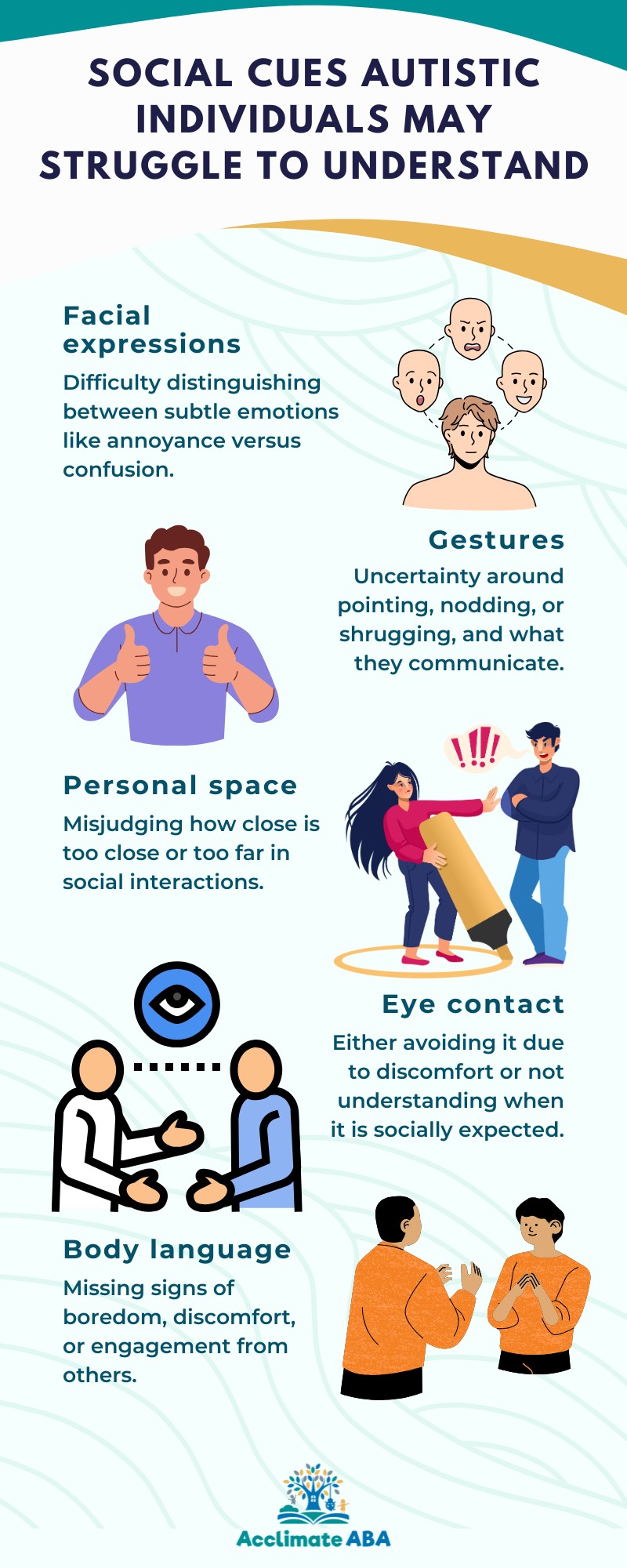Key Points:
- Many autistic individuals struggle with interpreting social cues like body language, tone, and facial expressions.
- This difficulty can lead to misunderstandings, isolation, and anxiety in everyday interactions.
- Strategies like direct instruction and ABA therapy can help build social understanding over time.
Understanding social cues can be challenging for many autistic individuals, and it’s one of the core areas where support is often needed. Nonverbal communication—including facial expressions, tone of voice, and body language—plays a major role in how we connect with others.
In this article, we’ll go over why social cue recognition is uniquely difficult for autistic individuals, how it impacts daily life, and what caregivers can do to offer support. Whether you’re a parent, educator, or therapist, gaining a clearer understanding of these challenges is the first step toward fostering connection, confidence, and social success.
Autism and Lack of Social Cues: What Does It Mean?
Autistic individuals often struggle to recognize and interpret nonverbal social cues, including facial expressions, body language, gestures, and tone of voice. These cues are essential for effective communication, and difficulty in recognizing them can lead to confusion or social missteps.
Social cues are a form of unspoken language. While neurotypical individuals often pick up on these signals automatically, many autistic people need explicit teaching and repeated practice to interpret them accurately. This doesn’t mean they lack empathy or interest in others—often, the opposite is true—but they may need different methods of learning and expressing social understanding.
Why are Social Cues Difficult for People With Autism?
The root cause of social cue challenges in autism is neurological. The brain processes social and emotional information differently. Areas related to facial recognition, emotional processing, and social prediction may function in unique ways, which affect how information is interpreted.
This can make everyday tasks—like knowing when someone is joking, reading a teacher’s frustration, or gauging when to speak in a group—difficult to navigate. These moments, though subtle to others, can become significant barriers for autistic individuals trying to connect and communicate.
Understanding which social cues are challenging is the first step toward support. Autistic individuals may miss or misread:

Each missed cue can lead to miscommunication or unintended offense, which may cause frustration for both the autistic individual and those around them.
How Does a Lack of Social Cue Awareness Affect Daily Life?
A lack of social cue awareness can make everyday interactions confusing and emotionally taxing for autistic individuals. Misinterpreting facial expressions, tone of voice, or body language often leads to misunderstandings, social isolation, and anxiety. These challenges can affect friendships, academic performance, and workplace dynamics.
Without guidance, autistic individuals may feel excluded despite wanting a connection. Difficulties with turn-taking, personal space, or detecting sarcasm can strain relationships. However, with early support and strategies like ABA therapy, many can improve their understanding of social cues and build meaningful interactions over time.
How Parents and Caregivers Can Support Social Understanding
While interpreting social cues may be challenging, it is a skill that can be taught, practiced, and improved over time. Parents play a critical role in creating opportunities for learning. Below are several ways caregivers can help:
1. Use Visual Supports
Visual aids like charts, emoji flashcards, or social stories help children recognize and interpret facial expressions, gestures, and emotions in a structured and accessible way.
2. Narrate Social Interactions
Describe what’s happening during real-life social moments, helping your child understand others’ actions and intentions in context. This builds insight into everyday nonverbal communication.
3. Model Social Behavior
Demonstrate appropriate social responses—like returning a smile or maintaining personal space—so your child can see, imitate, and internalize expected behaviors.
4. Practice Role-Play
Create playful, low-pressure scenarios to rehearse greetings, turn-taking, or expressing feelings, providing a safe environment to build confidence and fluency.
5. Break Down Interactions
After social situations, talk through what happened, pointing out successful moments and gently addressing any misunderstandings to help your child learn and grow.
6. Be Patient
Learning social cues takes time and repetition. Stay consistent and supportive, knowing that every attempt builds your child’s long-term social understanding and confidence.
Consistency, encouragement, and structure make a big difference in long-term growth.
How Does ABA Therapy Address Social Cue Challenges?
Applied Behavior Analysis (ABA) is a well-researched approach that focuses on improving social, communication, and daily living skills. It is particularly helpful in supporting social cue learning.
In the context of social challenges, ABA therapists can:
- Assess the specific cues that are difficult for an individual.
- Develop personalized goals and teaching strategies.
- Use reinforcement to shape socially appropriate responses.
- Teach social skills through direct instruction and modeling.
- Incorporate video modeling or peer interactions for more realistic practice.
Progress is tracked closely, ensuring that strategies evolve as the individual grows. ABA doesn’t just teach the “what” of social behavior, but also the “why,” which is crucial for generalization across settings. This deeper understanding of communication patterns—especially when they involve repeated phrases or scripted language—connects directly to the themes we explore in our article Understanding Echolalia and Repetition in Autism.
Can Social Cue Awareness Improve Over Time?
Yes, with intentional support, many autistic individuals can significantly improve their understanding and response to social cues. Progress looks different for everyone, but even small steps can greatly impact confidence and social inclusion.
Improvement depends on several factors:
- Early intervention: Starting support in childhood often yields better outcomes.
- Consistent practice: Regular exposure and teaching moments.
- Support network: Involvement of family, therapists, and educators.
- Motivation and self-awareness: When individuals understand the purpose behind the behavior, engagement improves.
Helping someone build these skills isn’t about changing who they are but giving them tools to express themselves and connect more easily with others.
Turn Small Steps Into Big Progress With ABA Therapy
If your child is struggling with interpreting social signals or managing social interactions, professional support can make a real difference. Acclimate ABA offers compassionate and evidence-based ABA therapy in Utah, tailored to help individuals with autism strengthen their social understanding and confidence.
Our therapists work one-on-one with families to develop strategies that are practical, individualized, and centered around meaningful progress. Get in touch with us today to explore how ABA therapy can help your child build stronger social skills and thrive in everyday interactions. Let’s work together to create supportive, inclusive pathways forward.

